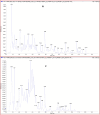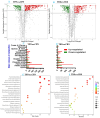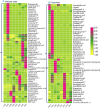Metabolomic and biochemical insights into bioactive compounds and antioxidant properties of black oilseed testa and peeled seeds
- PMID: 39737385
- PMCID: PMC11683268
- DOI: 10.1016/j.crfs.2024.100939
Metabolomic and biochemical insights into bioactive compounds and antioxidant properties of black oilseed testa and peeled seeds
Abstract
Black oilseed crops are rich in diverse phenolic compounds and have excellent antioxidant activities, as reported in traditional Chinese medicine. Testa (seed coat) and peeled seeds (cotyledon, embryo, and other structures) are the seed's crucial components, contributing to the variation in phytonutrient, phenol content, bioactive component, and protective and pharmacological effects. However, comprehensive and comparative information on total phenol, flavonoid, antioxidant, and metabolic profiles in black seed testa and peeled sesame, soybean, peanut, and rapeseed seeds is rare. Here, we investigated the metabolic profiles, phenolic contents, and antioxidant activities of four black oilseed crop testas and peeled seeds. This study revealed that testa has higher total phenol, flavonoid, and antioxidant activities than peeled seeds. A total of 1847 metabolites were identified across all samples and categorized into 17 major classes: flavonoids (20.02%), phenolic acids (15.15%), lipids (11.47%), amino acids and derivatives (9.36%), alkaloids (7.47%), organic acids (5.79%), terpenoids (5.68%), lignans (5.57%), saccharides (4.27%), and nucleotides and derivatives (4.17%) among the top ten. Primary class metabolites such as amino acids, saccharides, and vitamins were higher in the peeled seeds than in the testa, signifying the role of energy reservoirs and nutritive potential. However, flavonoids, phenolic acids, coumarins, chromones, lignans, terpenoids, tannins, organic acids, and lipids were abundant in the testa. Interestingly, the diversity and content of secondary metabolites were more abundant in the testa than in the peeled seeds of each crop, explaining their potential for phenol content, bioactivity, antioxidant activity, and pharmacological potential. The bioactivity of peeled seeds and testas may be associated with the phytochemical composition and content of flavonoids, phenolic acids, terpenoids, alkaloids, lipids, terpenoids, lignans, amino acids, and saccharides. Therefore, according to our results, peeled seeds offer higher nutritional value, and the testa has medicinal and protective properties. This study provides insights into the variations in phytochemical composition, phenolic content, and antioxidant activity of testa and peeled black sesame, soybean, peanut, and rapeseed seeds for further application of oilseeds in food products and to maximize nutritional benefits.
Keywords: Antioxidant activity; Bioactive compounds; Food chemistry; Oil crops; Peeled seeds; Phenol content; Testa.
© 2024 The Authors.
Conflict of interest statement
All authors declare that they have no personal, financial, or other conflicts of interest.
Figures















Similar articles
-
Widely targeted metabolic profiling provides insights into variations in bioactive compounds and antioxidant activity of sesame, soybean, peanut, and perilla.Food Res Int. 2023 Dec;174(Pt 1):113586. doi: 10.1016/j.foodres.2023.113586. Epub 2023 Oct 14. Food Res Int. 2023. PMID: 37986527
-
Metabolomic insights into the multiple stress responses of metabolites in major oilseed crops.Physiol Plant. 2024 Nov-Dec;176(6):e14596. doi: 10.1111/ppl.14596. Physiol Plant. 2024. PMID: 39575499 Review.
-
Comparative metabolomics analysis of different sesame (Sesamum indicum L.) tissues reveals a tissue-specific accumulation of metabolites.BMC Plant Biol. 2021 Jul 24;21(1):352. doi: 10.1186/s12870-021-03132-0. BMC Plant Biol. 2021. PMID: 34303354 Free PMC article.
-
Total polyphenols and bioactivity of seeds and sprouts in several legumes.Curr Pharm Des. 2013;19(34):6112-24. doi: 10.2174/1381612811319340005. Curr Pharm Des. 2013. PMID: 23448441 Review.
-
Antioxidant capacity of seed coat, dehulled bean, and whole black soybeans in relation to their distributions of total phenolics, phenolic acids, anthocyanins, and isoflavones.J Agric Food Chem. 2008 Sep 24;56(18):8365-73. doi: 10.1021/jf801196d. Epub 2008 Aug 27. J Agric Food Chem. 2008. PMID: 18729453
References
-
- Abib B., Afifi S.M., El-Din M.G.S., Farag M.A. How do cultivar origin and stepwise industrial processing impact Sesamum indicum seeds' metabolome and its paste and in relation to their antioxidant effects? A case study from the sesame industry. Food Chem. 2023;420 doi: 10.1016/j.foodchem.2023.136134. - DOI - PubMed
-
- Adedayo B.C., Anyasi T.A., Taylor M.J.C., Rautenbauch F., Le Roes-Hill M., Jideani V.A. Phytochemical composition and antioxidant properties of methanolic extracts of whole and dehulled Bambara groundnut (Vigna subterranea) seeds. Sci. Rep. 2021;11(1):1–11. doi: 10.1038/s41598-021-93525-w. - DOI - PMC - PubMed
-
- Attree R., Du B., Xu B. Distribution of phenolic compounds in seed coat and cotyledon, and their contribution to antioxidant capacities of red and black seed coat peanuts (Arachis hypogaea L.) Ind. Crop. Prod. 2015;67:448–456. doi: 10.1016/j.indcrop.2015.01.080. - DOI
LinkOut - more resources
Full Text Sources

